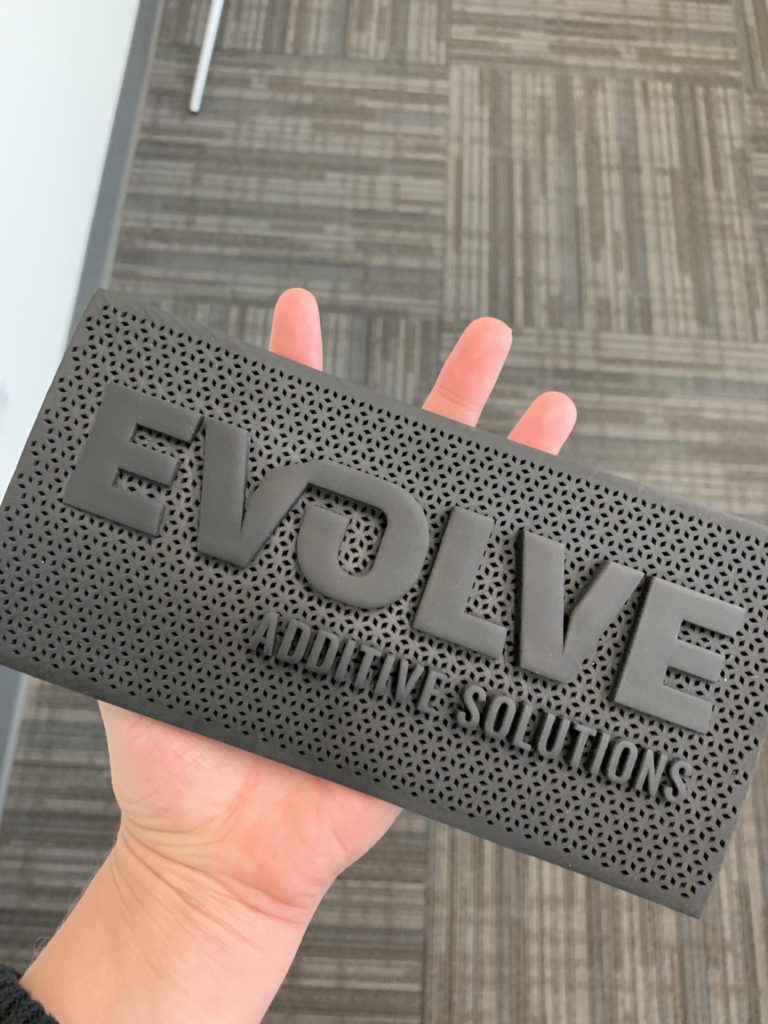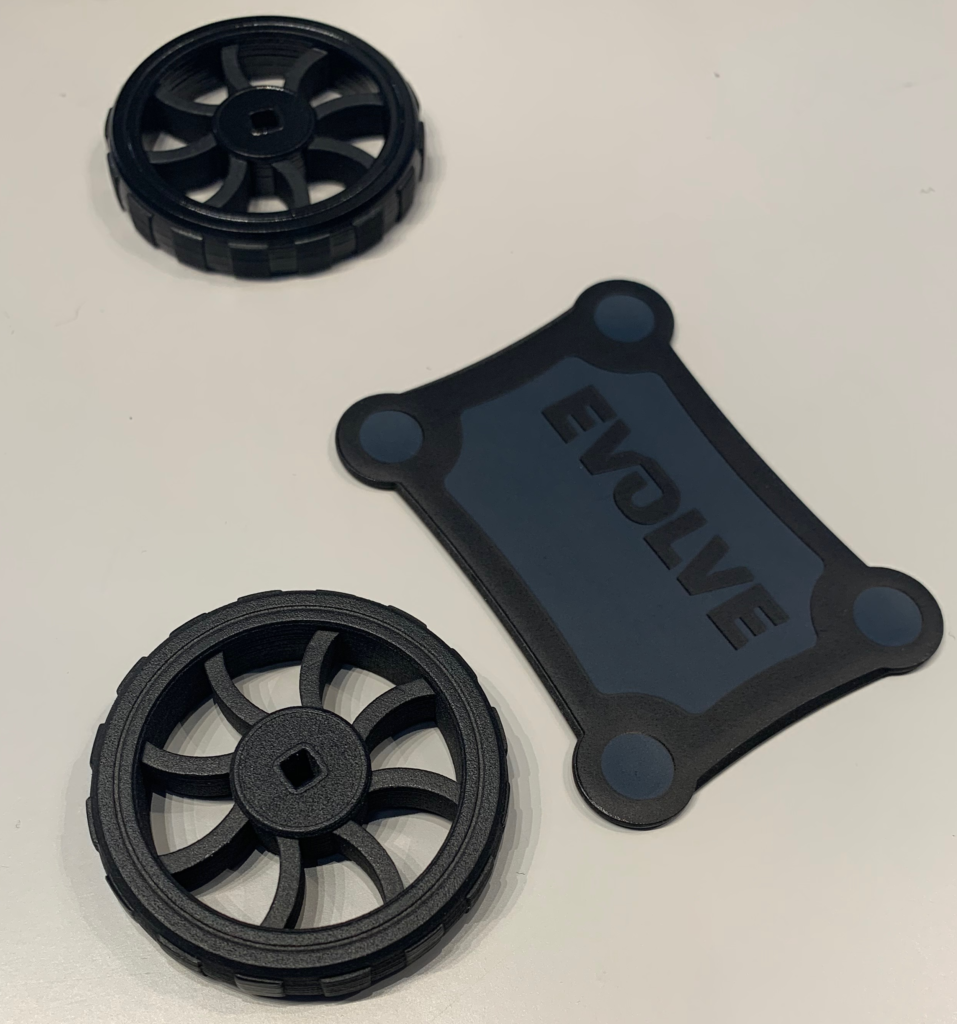Steve Chillscyzn started out as a mechanic on the venerable A-10 Warthog before moving into the mechanical engineering of printers. After 11 years leading design and engineering teams at Dell, Oce and others, he moved to Stratasys. For the next ten years, he’d manage mechanical engineering, move to leadership roles in R&D, before becoming the VP of Corporate Technology Development. All the while there was a project at Stratasys he was involved with that married 2D printing with 3D printing.
Fantastic rumors spread about this project and its capabilities. It was supposedly fast, cheap, with low part cost, great surface finish and made isotropic parts. It sounded too good to be true, solving all of 3D printing’s limitations. In 2018 Evolve was spun out of Stratasys, partnered with Kodak and received $18 million in investment from Lego and Stanley Black and Decker. Evolve’s claims now are still amazing with the system working with amorphous and semi-crystalline thermoplastics like ABS, isotropic, able to do multi-material in one single layer, able to do full color while having the same look and feel of injection molded parts. You could call Evolve’s Selective Toner Electrophotographic Process (STEP) a “Perfect Christmas” technology because it gives us all we ever wanted and more. It would be like dreaming of a fire engine red bicycle for Christmas and getting a bicycle and an actual full-scale fire truck.

STEP uses a laser printer engine to image a layer onto the surface of a drum, this imaged layer with positive and negative charges is rolled near 22-micron toner particles with the opposite charge, electrostatic force transfers the toner onto the charged areas. The image and toner is then rolled onto another roller and then onto a carrying belt. STEP places a voxel at a specific place in a layer, and can even place multiple voxels of materials at specific points. The mind boggles at what could be possible with that kind of technology. It is also notable that it is a completely new IP stack and completely new technology very different from existing ones.
One machine is being tested at the moment. So far we’ll have to take a lot of the company’s claims at face value. The parts that we can see look very crisp and consumer-friendly (albeit rather low in Z). If the company’s throughput claims hold true then we can hope for this being a technology that enables mass manufacturing with 3D printing. 12 years in the making Evolve made its debut this past Formnext where we spoke with Steve.

Steve says that, “the value proposition of Evolve Additive has..always been 100% directed at scaled production.” “The barriers to production in 3D printing have been: cost per part, throughput, limited material selection (not being able to use familiar engineering thermoplastics), not having the finish of injection molding technology, scalability.” He maintains that “solving these issues are the 5 pillars of STEP technology and Evolve Additive.” “In the eyes of the customers, all five have to be solved, not just one or two” for them to consider manufacturing with 3D printing. To do this the firm “has to work on..the machine, materials, and serviceability” because “we want to compete with injection molding.” Evolve isn’t looking for edge cases or particularly high-value parts or markets it really wants to take the battle to injection molding and compete with them head-on. “With 12 years of development..and building on laser printing technologies..” they feel up to that challenge.

The process works when “engineering thermoplastics are transformed into a toner. This fine micro powder is selectively deposited and then parts are thermally fused.” According to Steve STEP parts are “100% dense and XYZ strength is the same in all directions” and they can “process both amorphous semicrystalline materials” and they now have “ABS, PA, and TPU” and are working with BASF and Evonik on developing new materials. “On the software side“, they are “working with Siemens NX.. to integrate the print solution in manufacturing workflows.” The company really “wants to move towards manufacturing..and..compete with injection molding…in real numbers..one million or more parts..with scaled production.” In that kind of setup, Steve understands that “you can not have one single source..and multiple suppliers are needed.”
Most companies very early on make the choice to go open or closed. They either choose to let their customers use a wide array of materials and have cheaper part costs or they choose for the higher margins for them but tightly integrated easy to use closed systems. Evolve is thinking of a different model “whereby a new material” is developed, implemented and sold by Evolve “to begin with to let Evolve recoup our costs and build up inventory” and once this has happened the customer could buy it straight from the polymer company or other sources. I love this as a model since it could perfectly balance the need for lower costs and lots of polymer companies working on developing materials for a platform making the selection wide and not expensive. Meanwhile, it does reward pioneering polymer companies and work by Evolve on qualifying and implementing that material. This could be the perfect balance needed to involve polymer companies to grow a platform and also make manufacturers less fearful of being locked in.
For now, the firm is focused on “exploring all of the verticals” but especially things such as “consumer products…and mass customization.” It is early days now still though and STEP is “now working with a customer to iron out the kinks..in the alpha stage..on this generation one technology..they want to get one more Alpha in the field soon..and then enter into a Beta phase end 2020.”
Subscribe to Our Email Newsletter
Stay up-to-date on all the latest news from the 3D printing industry and receive information and offers from third party vendors.
Print Services
Upload your 3D Models and get them printed quickly and efficiently.
You May Also Like
The Market and Industry Potential of Multi-Material 3D and 4D Printing in Additive Electronics
Additive manufacturing leverages computer-based software to create components for products by depositing either dielectric or conductive materials, layer by layer, into different geometric shapes. Since its birth in the 1980s,...
3DPOD 262: Bio-inspired Design for AM with Dhruv Bhate, Arizona State University
Dhruv Bhate is an associate professor at Arizona State University. There, he looks at structures, materials, and design. Previously, he worked at PADT as well as in the semiconductor and...
3DPOD 261: Tooling and Cooling for AM with Jason Murphy, NXC MFG
Jason Murphy´s NXC MFG (Next Chapter Manufacturing) is not a generalist service; instead, the company specializes in making tooling. Using LPBF and binder jet, the company produces some of the...
3DPOD 260: John Hart on VulcanForms, MIT, Desktop Metal and More
John Hart is a Professor at MIT; he´s also the director of the Laboratory for Manufacturing and Productivity as well as the director of the Center for Advanced Production Technologies....
































